
|
Introduction Although sustainability is a contemporary concept of immense significance, it is an intangible abstract concept, a concise definition of which remains elusive. It essentially represents a paradigm shift in understanding the relationship between humanity and the environment and recognition that the present excessive demands of humanity on natural resources, coupled with excessive waste and pollution generation by human beings, constitute an unsustainable, stressed and threatened global environment. This has been brought into sharp focus over the past decade by increasing awareness of the consequences of global warming, believed to be due to increasing levels of greenhouse gases in the atmosphere derived from anthropogenic sources. However, although there are a number of global initiatives to reduce greenhouse gas emissions, there are by comparison limited initiatives underway to seriously address environmental sustainability. This may be due to a lack of a comprehensive theoretical framework for understanding ‘sustainable development’ and its multi-disciplinary complexities, since the range of published definitions is vague and it remains a contested topic, fraught with contradictions [1]. In this context, Hill and Mustafa [3] have argued that sustainable development is essentially consistent with sustainable natural resource management (SNRM) that embraces several dimensions including ‘social’, ‘political’, ‘scientific’, ‘technological’, ‘economic’, ‘research, innovation and development’ and, most importantly, ‘education’, which collectively form a concept framework, as shown in Fig. 1.
The IYC themes offer significant challenges for chemistry and hence for chemical education. It is evident that the rapid emergence and development of ‘green chemistry’ over the last decade has dramatically enhanced a positive (social) image of chemistry and the IYC themes not only continue this trend but also enable a transition towards sustainable chemistry. However, although it appears that green chemistry and sustainable chemistry are synonymous terms, Tundo [7] has suggested that there is a subtle difference in that sustainable chemistry has chemical processing connotations involving more energy efficient, less polluting chemical manufacturing processes which may generate greater profit margins, whereas green chemistry is more focused on ‘greening’ chemical reactions to produce products which are environmentally benign, but are not necessarily of industrial interest or significance. This differentiation of these terms widens the scope and the challenges for chemical education since the sustainability of the chemical enterprise has to be addressed using sustainable chemistry as the major driver. The aim of this paper is to identify the challenges for chemical education in enabling the transition of the chemical enterprise towards sustainability. Such a paper is timely since although environmental sustainability is a contemporary concept of immense significance and there are widespread calls to embed sustainability into tertiary curricula, courses emphasizing sustainability are currently limited and tend to be in non-science areas, with emphasis on economic, social and political sustainability [8]. Furthermore, the challenges for science education and chemical education in particular are formidable since embedding sustainability into chemical education involves identification of the major chemical concepts that relate to sustainability of the chemical enterprise and hence to environmental sustainability; consequently, a paradigm shift in chemical education pedagogy is envisaged.
As for ‘sustainable development’, there have been many definitions of ‘green chemistry’ which relate to the synthesis of environmentally benign molecules and materials, new chemical (energy efficient) processes and new quality control technologies which reduce effluent and waste [9]. These definitions imply that ‘green chemistry’ and ‘sustainable chemistry’ are closely inter-related since the vision of green chemistry is holistically aligned with environmental sustainability. With its direct linkages to other major science disciplines, such as the life sciences, materials science, chemical engineering and environmental science, and its indirect linkages to economics and ethics, together with its principal aim to provide benefits to society, green chemistry is rapidly changing the negative public image of chemistry which has prevailed for decades. The guiding principles of green chemistry, as shown in Fig.3, offer significant challenges for chemical education, since the mindset of students and researchers has to be changed to think and learn in terms of environmental sustainability rather than in terms of ‘pure chemical sustainability’, and the latter has to be addressed with reference to terms and concepts such as ‘atom economy’, ‘waste reduction’, ‘toxic versus benign’, ‘energy efficiency’, ‘renewable feed-stocks’, ‘quality control’ and ‘safety management’. Traditionally these terms and concepts have not been included in chemistry education [10]. If the ‘benign by design’ philosophy is introduced progressively into chemical education pedagogy at all levels, this will greatly assist in the production of trained personnel for sustaining the chemical enterprise. Sustaining the Chemical Enterprise The chemical enterprise is an amorphous concept composed of a myriad of interconnected parts, each of which has to be considered from a sustainability viewpoint, as shown in Fig.4. Green chemistry strategies target each stage of the lifecycle of a chemical product to continuously enhance its biological and ecological safety, reduce energy consumption associated with its production and eliminate the co-production of waste. Hence, green chemistry offers substantial reductions to the environmental footprint of chemical processes, improvements in the health and safety of those exposed to the manufacture of chemicals and safe handling of hazardous materials [11] leading to greater public recognition of the beneficial significance of the chemical enterprise. Poliakoff and Licence [12] have argued that although the chemical industry has over recent decades made significant efficiency improvements to the manufacture of ‘essential chemicals’, finite natural resources will inevitably limit sufficient quantities of essential chemicals to meet the demand of a rapidly increasing global population. Thus, the chemical industry is currently not sustainable, as shown by ‘E-factors’ greater than zero. (The E-factor for a chemical process is the ratio of the amount of waste generated compared to the amount of product produced, and thus it is a measure of the ‘green-ness’ of the process.) Since natural resources feed-stocks limit chemical industry E-factors, a sustainable chemical industry depends on achieving E-factors approaching zero by maximizing product yield and minimizing feed-stock input.
Greening the chemical industry is obviously a progressive exercise. Ananda et al. [13] have proposed a roadmap to a green (sustainable) chemical industry, based on a set of interactive principles broadly termed ‘economic’, ‘social’, ‘technological’, ‘cultural’, ‘political’ and ‘environmental’, which collectively form the ‘drivers of change’ in chemical industry policy planning and incorporate green chemical technology. This roadmap has considerable potential for moving the chemical enterprise towards sustainability, and by inference, reducing E-factors. A definitive and comprehensive study by Grassian and Meyer [14] has proposed that education and basic research in renewable energy resources, green chemistry and the environment play pivotal roles in the quest for sustainability, and have argued that a sustainable future calls for a carbon-neutral economy based on renewable (non-fossil) energy supplies and an enhanced understanding of the environmental impacts of increasing human consumption of natural resources. Thus, to address chemistry sustainability, chemical education has to be multi-disciplinary, encompassing not only new chemical concepts, but also the myriad of connections between these concepts and the chemical enterprise in order to reveal how the latter is linked to environmental sustainability. In view of the complexity and diversity of these connections, the challenges for chemical education are formidable. Sustainable Chemistry Education The accepted status of chemistry as the central (enabling) science has progressively been augmented by a rich research history dating back over at least a half century. Traditionally, chemical education has been considered as a combination of three major dimensions, as shown in Fig.5. With respect to teaching methodologies, Bedgood [22] has asked, ‘Why are we still teaching (Chemistry) the way we were in the 1980’s?’ He has been involved in a pioneering project aimed at enhancing science learning and teaching in Australian universities with a focus on first year science programs, which are characterised by large numbers of student participants, didactic teaching methods and multi-cultural learning environments. This program is piloting student-centred teaching methodologies in conjunction with student group learning strategies, fostering knowledge accumulation and enquiring minds. Further, Reid [23] has asked, ‘What do we know about how students learn in the sciences and how can we make our teaching match this to maximize performance?’ He has proposed new strategies for correlating teaching methods more directly with learning rates and learning outcomes and how well core concepts can be linked to form a meaningful outcome. But such well-intentioned ideas for learning chemistry are often met with challenges in the wake of more computer-oriented online approaches to teaching chemistry [24]. With respect to learning strategies and objectives, Mahaffy [25] has shown that there is an integral connection between chemical reactivity and human activity, and proposed that the traditional three levels of learning chemistry – ‘macroscopic’, ‘symbolic’ and ‘molecular’ – be extended to a fourth dimension ‘human element’. This proposal is consistent with the earlier proposal of Fensham [17] and also, most significantly, links chemical education to the IYC themes and their promulgation. However, it is timely to examine whether education in chemistry as it is currently practiced is sufficiently equipped to address the IYC themes and hence the sustainability paradigm. In this context, Hill and Mustafa [3] have proposed that the most significant manifestation of ‘sustainability’ is ‘sustainable natural resource management’ (SNRM), which correlates a sustainable environment with human endeavour. Furthermore, SNRM has many dimensions, a major one of which is ‘scientific’. Chemistry, and in particular, environmental chemistry is obviously a central component of the scientific dimension of SNRM, which, when combined with the ‘social’, ‘economic’, ‘technological’ and ‘research, innovation and development’, dimensions becomes a major driver of SNRM. Further, Hill and Warren [26] have shown that the sustainability theme can be embedded into the curriculum framework which Hill [19] has proposed for the tertiary foundation chemistry course. Mahaffy [27] has campaigned for the integration of environmental sustainability into chemical education consistent with chemistry being an integral influence on the global future of humanity in terms of secure energy supplies, and the consequences of climate change and of diminishing food and fresh water resources. Similarly, Nocera [28] has proposed that ‘carbon-neutral energy resources’ and ‘efficient energy use’ are the most pressing issues facing planet Earth in the 21st century, and that chemistry and chemical education have pivotal roles to play in addressing these challenges, since ‘the chemical bond is the currency of energy’. Further, Fanzo, Remans and Sanchez [29] have argued that ‘chemistry’ is the backbone of food and nutrition security and that hunger is one of the greatest threats to the sustainability of humanity; thus, chemical education has a pivotal role to play in revealing how food security is directly related to sustainable agriculture and aquaculture. Also, the cultural dimension of chemical education must not be overlooked. Kumar [30] makes a compelling case in Wilderer et al.’s [31] collection of essays ‘Global sustainability: The importance of local cultures’ – that local cultures markedly influence transitions towards sustainability, and in this context, sustainable chemical education plays a most significant role. Thus, it appears that a new vision for chemical education is required, encompassing many new dimensions, as suggested in Fig.6, if it is to address the challenges inherent in engaging environmental sustainability. 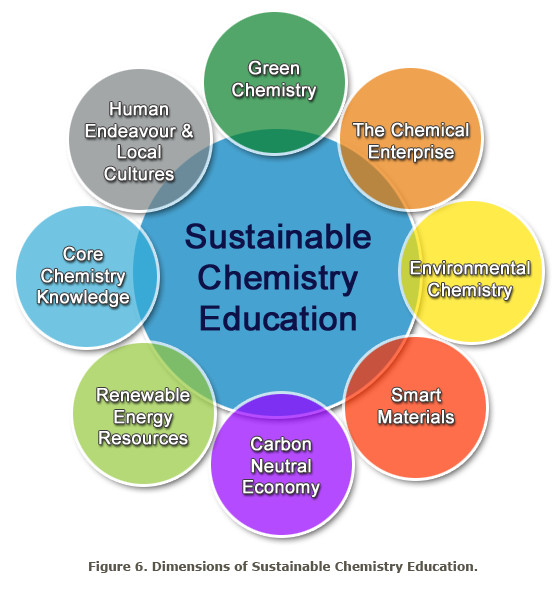 It is evident that sustainable chemistry education involves different methodologies in teaching fundamental chemistry concepts, whereby new terms and new philosophies are introduced. For example, chemical systems involving multiple chemical reactions need to be discussed in addition to examples of different types of single chemical reactions. Furthermore, chemical reactions need to be discussed in terms of ‘atom economy’ to illustrate the principle of chemical efficiency. The core topic of thermodynamics needs to be discussed in terms of energy efficiency of chemical processing and manufacture in addition to energetics and spontaneity of chemical reactions. The core topic of kinetics needs to be discussed in terms of selective catalysts, which maximise product yield by decreasing by-product formation. Such discussions interlink core chemistry knowledge with green chemistry principles and form the foundation on which sustainability of the chemical enterprise is progressed. As a consequence of such inclusions in chemistry curricula, a suite of new terms emerges such as ‘feedstock’ replacing ‘reactant’ and ‘E-factor’, which is the ratio of the mass of ‘waste’ compared to that of ‘product’. The latter is a simple empirical measure of the ‘green-ness’ of a chemical process and hence its sustainability [12]. Similarly, a discussion of ‘renewable energy resources’ must be prefaced by a discussion of present primary energy resources, namely fossil fuels, in order to address climate change; arguing that these have to be replaced progressively by clean, green, renewable energy resources, such as solar energy. However, the dilemma of this challenge must also be discussed, namely that all known commercially viable renewable energy resources combined are unlikely to meet global energy demands over the next two decades, and hence fossil fuels are most likely to dominate the global energy market for the foreseeable future. This leads to a discussion of clean coal technology and the contemporary concept of a ‘carbon-neutral economy’; both are outside the scope of contemporary chemical education, but are essential inclusions in the quest to extend chemical education to engage with sustainability. Sustainable chemistry also embraces environmental chemistry, whereby fundamental chemical concepts such as the p-block elements – C, N, O, P and S – are termed ‘nutrients’ and ‘salts’ are responsible for ‘salinity’ of soils and surface waters. Pollutants disturb the natural nutrient cycles and salinity reduces soil and freshwater quality with overall degradation of the natural environment. Similarly, increasing acidity of rivers and oceans disturbs aquatic ecosystems [32] and is a direct consequence of increased levels of carbon dioxide in the atmosphere. Furthermore, increasing toxicity of the environment due to chemical waste in soils, air and surface waters is of greatest concern in terms of addressing environmental sustainability. Sustainable chemistry intuitively involves engagement with the generation of new smart materials and hence with nanotechnology and its envisaged linkages to global clean energy requirements. The rapidly advancing nano-chemistry is perhaps the most significant exemplar of leading edge sustainable chemistry with its focus on the development of new smart materials for energy storage, production and conversion, for advancing agricultural productivity, water purification and desalination food processing, building construction, health monitoring and for pest control. Of these applications, rapid advancement in the production of photo-voltaic devices and carbon nano-tube solar cells [33] is accelerating the solar energy industry. Similarly, the development of nano-catalysts for hydrogen production, coupled with carbon nano-tube hydrogen storage systems are promoting hydrogen as a viable, alternative clean energy resource [26, 33]. Thus, sustainable chemistry via nano-chemistry directly engages with environmental sustainability by providing processes and products which directly benefit humanity without harming the environment. However, all of these dimensions of sustainable chemistry present formidable challenges for chemical education, both in terms of future direction and scope. It is clear that ‘sustainable chemistry’ cannot be considered as a single academic course, but requires the concept and philosophy of sustainability to be progressively introduced into all chemistry courses, both at the secondary and post-secondary/tertiary levels. Furthermore, the complexity of sustainable chemistry and the diversity attached to its implementation demand flexible teaching methodologies, such as Problem Based Learning supported with multimedia anchors [34], leading to carefully designed learning outcomes (research into which is, at best, embryonic). In conclusion, since ‘sustainability’ and ‘sustainable development’ are complex, multi-dimensional’ concepts, sustainable chemistry is also multi-dimensional in character, embracing disciplines not normally aligned with it such as economics, accounting, humanities, sociology, cultural studies, health sciences, food science and agricultural science. Hence, successful engagement of chemical education with sustainability involves developing partnerships with these disciplines to form a united educational platform for moving towards environmental sustainability. Fundamentally, sustainable chemistry education is a powerful philosophy integrating ‘chemistry’ into the ‘sustainable future’ syndrome and offers challenging educational opportunities to achieve identifiable sustainable outcomes. Acknowledgement The authors gratefully acknowledge the support of Dr. Alberto Fernández for his assistance in the re-creation of the article’s figures. References
|
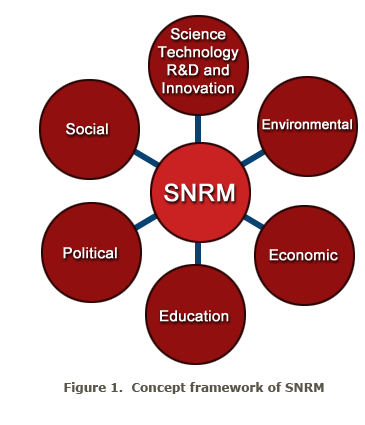 The many definitions of sustainable development are largely benchmarked to the World Commission on Environment and Development (WCED) definition [2]: ‘maintaining the needs of the present generation without compromising the ability of future generations to meet their needs’. There is much debate on ‘what are the needs (and scale) of present generations’ in the context of the ‘haves’ and ‘have-nots’ disparity and ‘what are the needs (demands) of future generations’, as the global population continues to escalate and the ‘haves and have-nots’ divide widens. Furthermore, there is much concurrent debate on how simultaneous harmonization of the needs of humanity with the needs of the environment can be achieved. It is intuitively obvious that ‘sustainable development’, and hence ‘environmental sustainability’, are progressive objectives and that metrics of these concepts need to be established in conjunction with tangible and workable definitions.
The many definitions of sustainable development are largely benchmarked to the World Commission on Environment and Development (WCED) definition [2]: ‘maintaining the needs of the present generation without compromising the ability of future generations to meet their needs’. There is much debate on ‘what are the needs (and scale) of present generations’ in the context of the ‘haves’ and ‘have-nots’ disparity and ‘what are the needs (demands) of future generations’, as the global population continues to escalate and the ‘haves and have-nots’ divide widens. Furthermore, there is much concurrent debate on how simultaneous harmonization of the needs of humanity with the needs of the environment can be achieved. It is intuitively obvious that ‘sustainable development’, and hence ‘environmental sustainability’, are progressive objectives and that metrics of these concepts need to be established in conjunction with tangible and workable definitions.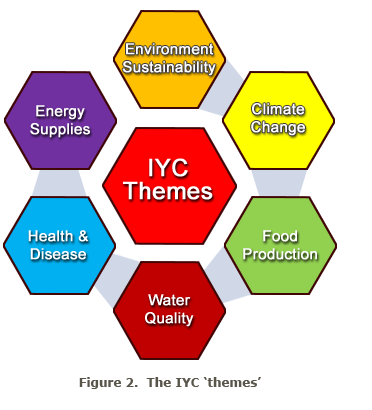 It emerges that since environmental degradation is largely due to the excessive needs of humanity, environmental sustainability is the responsibility of humanity, and thus sustainability education is of paramount importance [4]. Science education and chemical education in particular are crucial components of sustainability education [5] since the former informs and enables the climate change debate and the latter emphasizes how green chemistry and green chemical industries enhance the transition to environmental sustainability. Also, the UN declaration of 2011 as the International Year of Chemistry (IYC) [6] established a roadmap for the future of chemistry (and hence chemical education) by defining a series of ‘themes’, all of which relate to addressing the most critical problems facing humanity in the 21st century, as summarized in Fig. 2, of which ‘environmental sustainability’ is the primary theme.
It emerges that since environmental degradation is largely due to the excessive needs of humanity, environmental sustainability is the responsibility of humanity, and thus sustainability education is of paramount importance [4]. Science education and chemical education in particular are crucial components of sustainability education [5] since the former informs and enables the climate change debate and the latter emphasizes how green chemistry and green chemical industries enhance the transition to environmental sustainability. Also, the UN declaration of 2011 as the International Year of Chemistry (IYC) [6] established a roadmap for the future of chemistry (and hence chemical education) by defining a series of ‘themes’, all of which relate to addressing the most critical problems facing humanity in the 21st century, as summarized in Fig. 2, of which ‘environmental sustainability’ is the primary theme.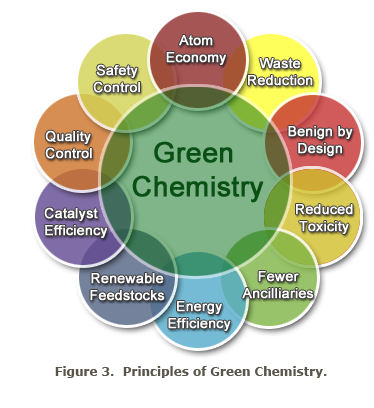 Influence of Green Chemistry
Influence of Green Chemistry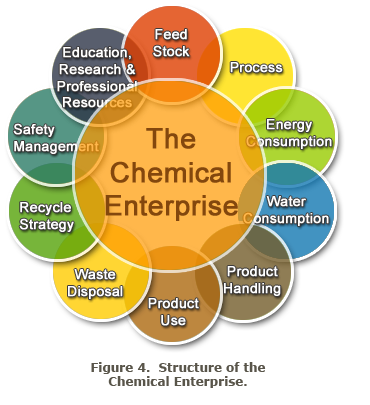 The E-factor metric presents further challenges for chemical education, since most chemical manufacturing processes produce by-products which are typically regarded as waste materials. E-factors can be reduced by recycling and/or reusing such by-products, but this has to be economically viable. Thus, chemical education has to address not only the chemical reactions involved in an industrial manufacturing process, but also reveal the complexities and intricacies of ‘stoichiometric economics’, which is the basis of the so-called ‘measurement science’.
The E-factor metric presents further challenges for chemical education, since most chemical manufacturing processes produce by-products which are typically regarded as waste materials. E-factors can be reduced by recycling and/or reusing such by-products, but this has to be economically viable. Thus, chemical education has to address not only the chemical reactions involved in an industrial manufacturing process, but also reveal the complexities and intricacies of ‘stoichiometric economics’, which is the basis of the so-called ‘measurement science’.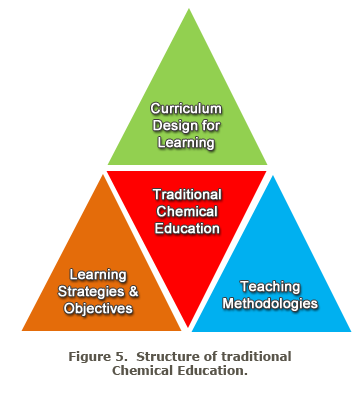 Over the last two decades, there have been some notable developments of these dimensions. With respect to curriculum design, Atkins [15] has proposed that ‘chemistry is based on just a few simple ideas’, which has not only led to finalizing the constitution of the long-debated ‘core of chemistry knowledge’ [16], but also to the re-evaluation of the content and context of secondary and tertiary chemistry courses in conjunction with more effective learning strategies. Also, Fensham [17] has proposed that ‘science has social responsibilities’, which has been interpreted by Hill [18] from a chemistry perspective. Furthermore, with respect to addressing a new vision for tertiary basic chemistry courses, Hill [19] has designed a curriculum framework for these courses which embraces the proposals of Atkins [15] and Fensham [17] and which leads to defined learning outcomes. However, it should be noted that “chemistry knowledge” alone is not sufficient to resolve issues such as toxic waste disposal, climate change consequences and nuclear energy concerns [20]. Chemical education is critical as “education is an essential element of all aspects of a transition to sustainability” [21].
Over the last two decades, there have been some notable developments of these dimensions. With respect to curriculum design, Atkins [15] has proposed that ‘chemistry is based on just a few simple ideas’, which has not only led to finalizing the constitution of the long-debated ‘core of chemistry knowledge’ [16], but also to the re-evaluation of the content and context of secondary and tertiary chemistry courses in conjunction with more effective learning strategies. Also, Fensham [17] has proposed that ‘science has social responsibilities’, which has been interpreted by Hill [18] from a chemistry perspective. Furthermore, with respect to addressing a new vision for tertiary basic chemistry courses, Hill [19] has designed a curriculum framework for these courses which embraces the proposals of Atkins [15] and Fensham [17] and which leads to defined learning outcomes. However, it should be noted that “chemistry knowledge” alone is not sufficient to resolve issues such as toxic waste disposal, climate change consequences and nuclear energy concerns [20]. Chemical education is critical as “education is an essential element of all aspects of a transition to sustainability” [21].